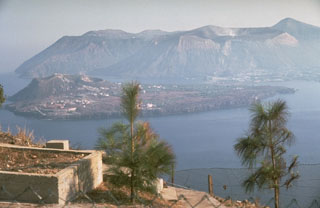Report on Vulcano (Italy) — October 1994
Bulletin of the Global Volcanism Network, vol. 19, no. 10 (October 1994)
Managing Editor: Richard Wunderman.
Vulcano (Italy) Fumarole observations and temperatures from Gran Cratere
Please cite this report as:
Global Volcanism Program, 1994. Report on Vulcano (Italy) (Wunderman, R., ed.). Bulletin of the Global Volcanism Network, 19:10. Smithsonian Institution. https://doi.org/10.5479/si.GVP.BGVN199410-211050
Vulcano
Italy
38.404°N, 14.962°E; summit elev. 500 m
All times are local (unless otherwise noted)
"Gran Cratere was visited on 7 and 11 October 1994 by Open Univ geologists and observations were made of the fumarole zone, which extends from the floor of the lower crater to the rim of the upper crater, and onto the NE outer crater flanks. On 7 October, temperatures of >500 fumaroles were measured (table 2) with a Minolta/Land Cyclops Compac 3 hand-held radiometer (8-14 mm). The only area within the fumarole zone not sampled was that extending from the rim of the lower crater to its floor. Because radiant temperatures have not been corrected for spectral emissivity, all are given as brightness temperatures.
Table 2. Summary of fumarole and fissure temperatures measured at Gran Cratere, Vulcano, 7 October 1994. The upper temperature range of the Compac 3 is given as 500°C by the manufacturer. Courtesy of A. Harris, Open Univ.
| Area | Temperature | Mean Temperature | Number of fumaroles |
| Upper crater NE rim: S half | 88.7-305°C | 161°C | 105 |
| Upper crater NE rim: N half | 93.3-449°C | 188°C | 45 |
| Fissures cutting the N end of upper crater rim fumarole zone | 134-345°C | 257°C | 64 |
| Upper crater inner flank: Upper slopes, S half | 107-315°C | 184°C | 56 |
| Upper crater inner flank: Upper slopes, N half | 92.7-334°C | 169°C | 98 |
| Upper crater inner flank: Lower slopes, S third | 112-362°C | 213°C | 36 |
| Upper crater inner flank: Lower slopes, middle third | 115-506°C* | 363°C | 39 |
| Upper crater inner flank: Lower slopes, N third | 117-485°C | 297°C | 39 |
| Bench between foot of the upper crater and the lower crater rim | 113-371°C | 222°C | 22 |
"Fumaroles along the crater rim are located in a sinuous 1-3 m wide fissure that runs along the NE crater rim for ~200 m. Within this zone, low-temperature (54-148°C) and medium-temperature (164-286°C) fumaroles dominate and sublimates are common. Maximum temperatures (305-449°C) came from fumaroles within gray rubble-filled depressions, which occurred less commonly along this fissure line. The crater rim fumaroles were bounded at the N end by a rubble-filled fissure, ~60 m long, which cuts the rim obliquely with a N-S trend and extends onto the outer and inner slopes of the crater. This fissure contains fumaroles at temperatures between 134 and 345°C (table 2). The upper slopes of the inner NE flank of the upper crater and S edge of the fumarole zone were dominated by low- to medium-temperature fumaroles, with less common high-temperature fumaroles in rubble-filled depressions and fissures. However, the lower slopes of the inner NE flank of the upper crater were dominated by an area (~70 x 15 m) of gray rubble and high-temperature fumaroles (211-507°C), with lower temperature fumaroles (60-191°C) and sublimates far less common. High temperatures were found in the middle and towards the N side of this area. During measurements there was constant discharge of gases from the fumaroles."
Geological Summary. The word volcano is derived from Vulcano stratovolcano in Italy's Aeolian Islands. Vulcano was constructed during six stages over the past 136,000 years. Two overlapping calderas, the 2.5-km-wide Caldera del Piano on the SE and the 4-km-wide Caldera della Fossa on the NW, were formed at about 100,000 and 24,000-15,000 years ago, respectively, and volcanism has migrated north over time. La Fossa cone, active throughout the Holocene and the location of most historical eruptions, occupies the 3-km-wide Caldera della Fossa at the NW end of the elongated 3 x 7 km island. The Vulcanello lava platform is a low, roughly circular peninsula on the northern tip of Vulcano that was formed as an island beginning more than 2,000 years ago and was connected to the main island in about 1550 CE. Vulcanello is capped by three pyroclastic cones and was active intermittently until the 16th century. Explosive activity took place at the Fossa cone from 1898 to 1900.
Information Contacts: A. Harris, Open Univ.

